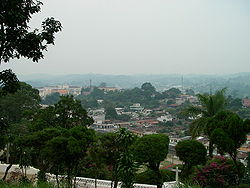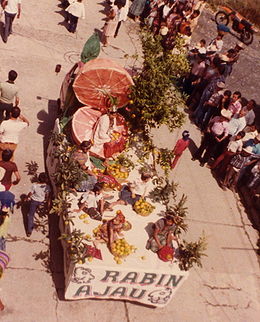- Cobán
-
Cobán, Alta Verapaz, Guatemala
Kob'an (Q'eqchi language)Nickname(s): Ciudad Imperial (Spanish: Imperial City) Location in Guatemala Coordinates: 15°29′0″N 90°22′0″W / 15.483333°N 90.366667°WCoordinates: 15°29′0″N 90°22′0″W / 15.483333°N 90.366667°W Country  Guatemala
GuatemalaDepartment Alta Verapaz Founded August 4, 1543 Government – Mayor of Cobán Leonel Antonio Chacón Barrios Area – Total 2,132 km2 (823.2 sq mi) Elevation 1,320 m (4,331 ft) Population (2005) – Total 93,633 [1] – Metro density 97/km2 (251.2/sq mi) Time zone GMT -6 Website www.inforpressca.com/coban/index.php The city of Cobán is the capital of the department of Alta Verapaz in central Guatemala. It also serves as the administrative center for the surrounding Cobán municipality. It is located 219 km from Guatemala City.
In 2005 the city's estimated population was 86,202. The population of the municipality, which covers a total terrain of 1312 km², was 94,000 people. Cobán, at a height of 1320 m above sea level, is located at the center of a major coffee-growing area.
Contents
History
The city was founded by Dominican friars in 1543. It received the title of an imperial city by Charles V, Holy Roman Emperor. The name Cobán originates from the Q'eqchi', the town's second language. There are several interpretations, one of which is Cob An (foggy place). In 1599 Cobán became bishop's see. The Ferrocarril Verapaz, a railway which connected Cobán with Lake Izabal, operated from 1895 until 1963 and was a symbol for the wealth in this coffee-growing region those days.
Germans in Cobán
The city was developed by German coffee growers towards the end of the 19th century and was operated as a largely independent dominion until WWII. In 1888 a German club was founded. [2] and in 1935 a German school opened its doors in Cobán. Until 1930, about 2000 Germans populated the city [3]. In 1941, all Germans were expelled by the Guatemalan government, led at the time by Jorge Ubico. Some say the reason was pressure from the United States. It has been suggested Ubico's motivation was to seize control of the vast amounts of land Germans owned in the area.[1] Whatever the case may be, it is a fact that many of the Alta Verapaz Germans sympathized with the German Nazi movement. Many ended up in internment camps in Texas and were later traded for American POW's held in Germany. A sizable resident German population persists though most having been completely assimilated into the Guatemalan culture through intermarriage. Multiple German architectonical elements can still be appreciated throughout Cobán.
Culture
Each year at the end of July, a festival of Guatemala's native peoples is held here, La Fiesta Nacional Indígena de Guatemala(Festival Folklórico). The festivities include a beauty contest for Guatemala's Native American women, the winner of which is crowned with the title "Rabin Ahau", which means "the Daughter of the King" in Q'eqchi'. The dominant ethnicity here is Q'eqchi mayan and the language of Q'eqchi is widely spoken in town, especially in an around the markets where farmers from the surrounding hills sell their products. The departmental fair is held in Cobán and begins on the last Sunday in July and continues for a week. Every year the International half Marathon of Cobán is held during the month of May, 4,000 runners gather in Cobán to take part of the event that has become the landmark event for the region. The annual religious festival (fiesta titular) is on August 4 and dedicated to Santo Domingo de Guzman.
Sports
Cobán Imperial Football Club is one of the traditional clubs of Guatemala and became Guatemala League champions for the first time in 2004. The club now play in the second division. They play their home games in the Estadio Verapaz. Cobán is also known for their basketball history. The youth leagues are the best in the country.
Nature
Cobán is surrounded by mountains laden with orchids, the rare Monja blanca orchid is the departmental symbol. Nature reserves in or near Cobán include Las Victorias National Park, San José la Colonia National Park, Laguna Lachuá National Park, and Biotopo Mario Dary Rivera. There can be found multiple caves, waterfalls and forests which are home to the rare Quetzal. Thus, Cobán has become a popular spot for eco-tourism.
Attractions in town
Popular tourist spots in the city of Cobán include the El Calvario Church, the Dieseldorff coffee plantation, the Principe Maya Archaeological Museum, and Coban's central plaza.
Sister Cities
 Birmingham, Alabama, USA[2]
Birmingham, Alabama, USA[2]
External links
- Cobán municipality (in Spanish)
References
- ^ Bitter Fruit: The Story of the American Coup in Guatemala
- ^ List of sister cities in Guatemala from Sister Cities International
Capital: CobánMunicipalities Chahal · Chisec · Cobán · Fray Bartolomé de las Casas · Lanquín · Panzós · Raxruha · San Cristóbal Verapaz · San Juan Chamelco · San Pedro Carchá · Santa Cruz Verapaz · Santa María Cahabón · Senahú · Tactic · Tamahú · Tucurú · Santa Catalina la TintaCategories:- Municipalities of the Alta Verapaz Department
- Populated places in Guatemala
- Populated places established in 1543
Wikimedia Foundation. 2010.





